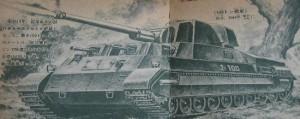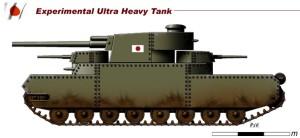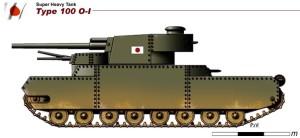WoT Japanese Heavy Tanks pt1
WoT Japanese Heavy Tanks pt2
Japanese heavy tanks on WoT, general infos – WG devs started to talk about a new japanese heavy tanks tree. The info about these tanks are very rare online and books often talk about only medium tanks. So we take stock of the situation through the few sources on books and Net. The heavy tanks were useless to the japanese intentions and on battlefields with dense vegetation. As result heavy tanks remained only on prototype stages and only few vehicles were build. The development of a 100 ton tank (O-I 100 ton) stemmed from defeat inflicted by Red Army in Nomohan/Khalkin Gol incident of 1939. The army issued an order to build a gigantic tank that can be used on plains of Manchuria. The tank was built in 1940, but the tests revealed problems to suspension, the project was abandoned and tank scrapped. At the end of war the critical situation of Imperial Japan pushed to develop a new Super Heavy Tank, the O-I 120 ton. The main armament of tank was a turret with a 105mm type 92 gun. Another two small turrets were installed on front. One carried a 47mm type 1 gun and the second a 7.7mm machine gun. On rear of tank another two machine gun turrets were installed. This vehicle was like a land battleship, an anachronistic project. The armor was strong too: 200mm on front, 110mm on side. Twin BMW aircraft engine (V12 aircooled), which gave a total of 1100 hp, powered the vehicle. The total weight oftank was between 120 and 150 tons. It’s possible that a prototype was built, but no photos have been discovered, only one picture that shows a giant turret behind two soldiers. It’s possible that this turret was the main turret of the super O-I.
Sources – K.W. Estes, Super heavy tanks of World War II, pop. 37-38

Carri pesanti giapponesi su WoT, notizie preliminari – la WG ha iniziarto a parlare di carri pesanti giapponesi, con data di rilascio entro 2015.Le notizie su questi carri sono ridotte a poche informazioni sparse in rete e nei pochi libri pubblicati. Pur non essendo semplice creare un quadro di insieme delle notizie, si deve sottolineare la non necessità da parte dell’esercito giapponese di carri pesanti, legati soprattutto ai teatri di guerra, sfavorevoli all’utilizzo di mezzi di grandi dimensioni (si pensi alle foreste tropicali o equatoriali). L’esigenza di un carro pesante nacque tuttavia nel 1939 a seguito di una sconfitta inflitta all’esercito giapponese dell’Armata Rossa presso Nomohan/Khalkin, non lontano dalla Manciuria. Fu allora che si pensò ad un carro adatto ai terreni pianeggiati in grado di reggere il fuoco dell’artiglieria nemica. Il progetto prevedeva un mezzo di circa 100 tonnellate e un prototipo venne costruito nel 1940.  E’ probabile che usufruisse di più torrette, una principale, più grande, e almeno altre due anteriori. I primi testfallirono per la presenza di sospensioni inadatte a sostenere il peso del mezzo durante i lunghi tragitti. Il fallimento decretò la fine del progetto e il veicolo venne smantellato. La macchina da guerra giapponese si orientò su mezzi più contenuti. tuttavia alla fine della Seconda Guerra Mondiale, complice la disperata situazione e i progetti tedeschi, venne rispolverata, nel 1944, l’idea di un carro super pesante, l’O-I 120 tonnellate. In questo caso la progettazione fu più accurata. Il veicolo manteneva le idee giè espresse nel 1939, multi torretta con molti membri di equipaggio. Il cannone principale era un 105mm e un doppio motore BMW erogava una potenza complessiva di 1100cv. La corazza era molto spessa, circa 200mm frontali e 110mm laterali. Quale fu il destino del carro non è dato saperlo. Si ritieneche anche in questo caso un prototipo venisse costruito. Ne esistono i progetti ma non le foto, sebbene ultimamente in rete circoli un’immagine che ritrae una gigantesca torre dietro due soldati. La torre nelle fattezze ricorda a grandi linee quelle montate sui carri medi giapponesi costrutti alla fine del conflitto (Chi-To e Chi-Ri). non si esclude che la torre fosse quella del carro super pesante e che venisse riciclata come batteria costiera.
E’ probabile che usufruisse di più torrette, una principale, più grande, e almeno altre due anteriori. I primi testfallirono per la presenza di sospensioni inadatte a sostenere il peso del mezzo durante i lunghi tragitti. Il fallimento decretò la fine del progetto e il veicolo venne smantellato. La macchina da guerra giapponese si orientò su mezzi più contenuti. tuttavia alla fine della Seconda Guerra Mondiale, complice la disperata situazione e i progetti tedeschi, venne rispolverata, nel 1944, l’idea di un carro super pesante, l’O-I 120 tonnellate. In questo caso la progettazione fu più accurata. Il veicolo manteneva le idee giè espresse nel 1939, multi torretta con molti membri di equipaggio. Il cannone principale era un 105mm e un doppio motore BMW erogava una potenza complessiva di 1100cv. La corazza era molto spessa, circa 200mm frontali e 110mm laterali. Quale fu il destino del carro non è dato saperlo. Si ritieneche anche in questo caso un prototipo venisse costruito. Ne esistono i progetti ma non le foto, sebbene ultimamente in rete circoli un’immagine che ritrae una gigantesca torre dietro due soldati. La torre nelle fattezze ricorda a grandi linee quelle montate sui carri medi giapponesi costrutti alla fine del conflitto (Chi-To e Chi-Ri). non si esclude che la torre fosse quella del carro super pesante e che venisse riciclata come batteria costiera.


